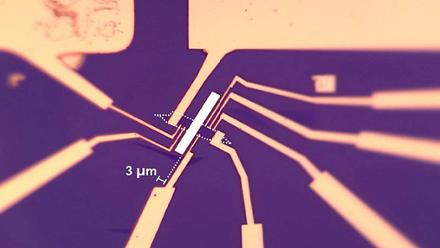Graphene enabled e-textile for future human-machine interfaces
Grafren AB, a Swedish chemical manufacturer and Associated Member of the Graphene Flagship, has been granted its first patent for a new method of separating graphene flakes.

The company, originally a spin out from Linköping University, is a manufacturer of smart textiles that specialises in producing graphene flakes and applying these to textiles and other products.
The patent covers a method to treat large volumes of graphene dispersions which involves separating graphene flakes into different fractions based on their thickness and lateral size. The main benefit of this technology is that it allows the separation of thinner flakes from those that are thicker than ten atomic layers or include bulk inclusions and other contaminants.
The process allows the preparation of water dispersions of single and double-layer flakes of graphene oxide and graphene. The thickness of the material is directly related to the flakes’ hardness and their bending ability.
Grafren’s method also uses gravity and is based on the difference between the floatation and sedimentation speed of graphene and graphene oxide flakes in the liquid dispersion. It is said to be economically-viable for large-scale graphene production because it requires less energy and minimal labour.
Thanks to this separation method, Grafren has obtained high-quality graphene flakes to use in electrically conductive textiles , where graphene flakes are woven into the depth of the fabric, wrapping every individual fibre and creating a conductive skin with controlled electrical conductivity. Grafren filed a second patent for this in 2020, which is now pending.
Currently, the size of fabric is limited to 100 x 100 cm. The company aims to reach 180 cm wide full roll-to-roll production by the end of 2021.
The organisation says it can make any textile or fibered material, including glass fibres, conductive. Conductive glass fibres are especially interesting for smart composite materials, and Grafren is talking with companies in a variety of sectors including healthcare, sport, aerospace, defence and gaming.
Next steps include potentially applying a layered material with high insulation capabilities to the graphene-coated fibres, such as hexagonal boron nitride to potentially create a printed circuit board (PCB) that’s integrated into a piece of fabric.
Ultimately, the future concept desired is a digital textile interface (DTI) for human-machine communication. The idea is to integrate invisible electrodes into conventional clothes, which will enable the permanent monitoring and stimulation of the human body by sensors or actuators.
The technology will be able to transfer signals to the human body — such as transcutaneous electrical nerve stimulation for pain control, heat or any other kind of stimulus. It could be used to monitor human health or motion through electrodermal, electrocardiogram and other sensors, and then pass this vital information on to a data processing or storage unit.










